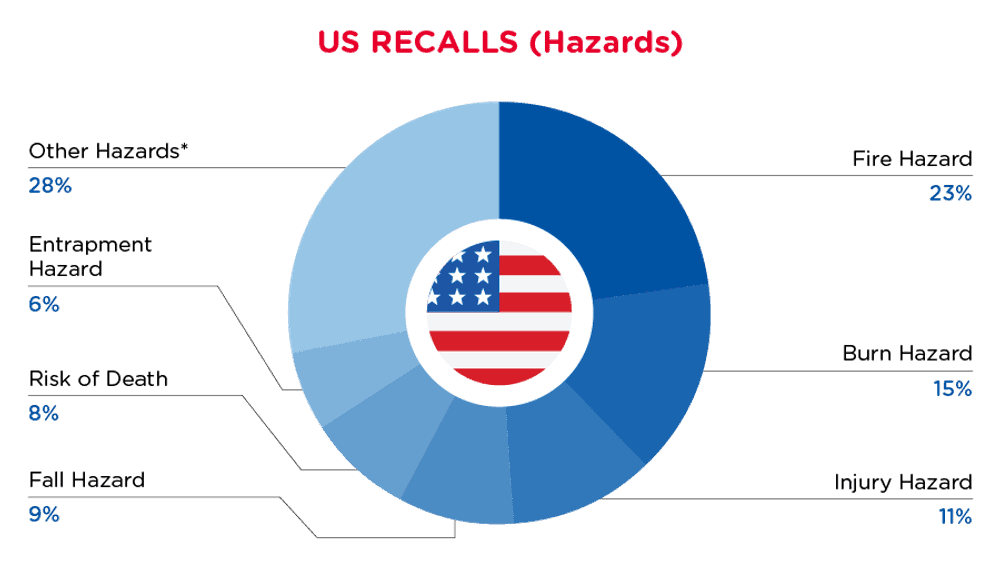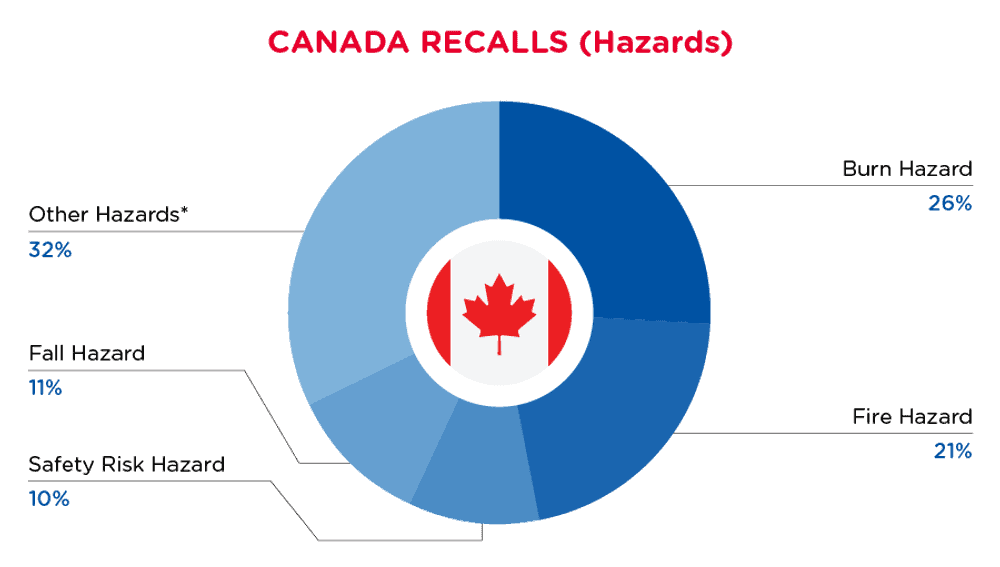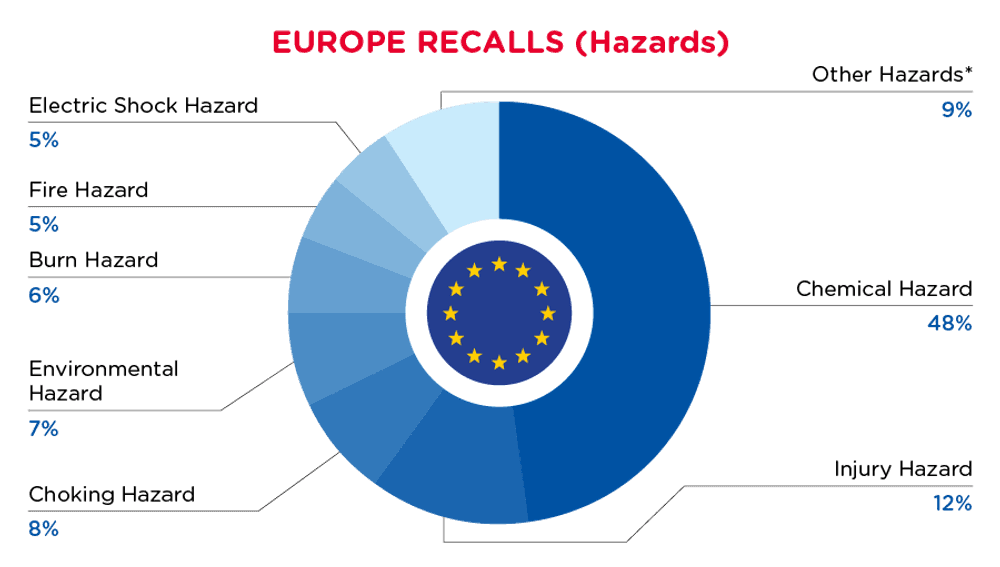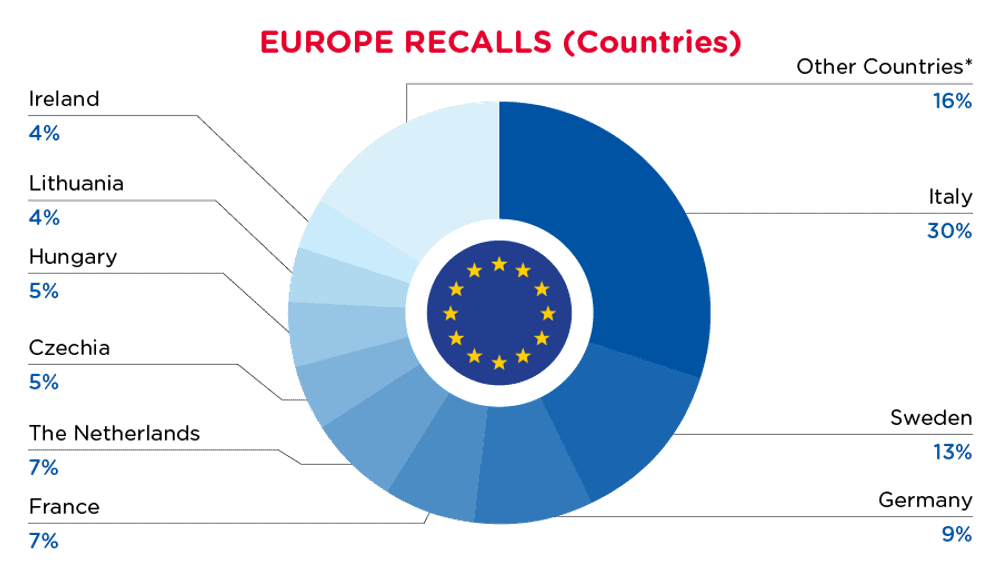July 2024
North America News
In June 2012, the U.S. Consumer Product Safety Commission (CPSC) published a consumer product safety standard for infant swings under section 104 of the Consumer Product Safety Improvement Act of 2008 (CPSIA). The standard incorporated by reference is updated to reference ASTM F2088-24, Standard Consumer Safety Specification for Infant and Cradle Swings. The rule is effective on 14 September 2024, unless the Commission receives a significant adverse comment by 1 July 2024.
ASTM has now issued a revised standard, ASTM F2088–24, Standard Consumer Safety Specification for Infant and Cradle Swings. Consistent with the CPSIA update process, this direct final rule updates the mandatory standard, 16 CFR 1223, to incorporate by reference ASTM’s 2024 version of the voluntary standard. It also revises the mandatory standard to include ‘‘cradle swings’’ to align with the voluntary standard.
Contains substantive changes to requirements in section 6.9 that address the strangulation and entrapment hazard to non-occupants associated with tethered straps and cords on swings
Addresses the head entrapment and strangulation hazard. The revised requirements and corresponding test methods ensure that any openings bounded by the strap are either too small for an infant’s head to enter or are large enough for the infant’s head to escape.
Includes revised provisions in the Performance Requirements section (section 6.9) and Test Methods section (section 7.16).
Adds the use of a 3/4-inch diameter clamping surface tool during the strap/cord evaluation test method to ensure consistency during the application of the pull force.
Specifies during the assessment of the bounded openings, the insertion forces to be used with the small and large head probes. The insertion forces allow for compression of soft goods in the testing area and consistency in testing.
Includes a provision in the test methods to use a 7.4-inch circumference cylindrical probe to evaluate the strap/cord length and tautness after the large head probe test in the evaluation of the bounded opening
Includes new figures to provide dimensions and illustrations of some probes
Includes several minor additions and revisions that are editorial and do not alter any substantive requirements in the standard.
The rule is effective on 14 September 2024, unless the Commission receives a significant adverse comment by 1 July 2024.
New Regulations have been enacted specific to the prohibition of mercury-containing lighting products in the state of Minnesota.
To protect the environment and public health, Minnesota has enacted a new law prohibiting the sale and distribution of mercury-containing general-purpose lighting products. The regulations are as follows:
Effective Dates:
Starting 1 January 2025: The sale, offering for sale, or distribution of newly manufactured screw- or bayonet-base compact fluorescent lamps (CFLs), mercury vapor lamps, and mercury vapor lamp ballasts is prohibited.
Starting 1 January 2026: The sale, offering for sale, or distribution of newly manufactured pin-base compact fluorescent lamps or linear fluorescent lamps is prohibited.
Exemptions:
The following lighting products are exempt from this prohibition:
Lamps designed and marketed exclusively for image capture and projection (e.g., photocopying, printing, film projection).
Lamps emitting a high proportion of ultraviolet light used for germicidal purposes, disinfection, fly-trapping, ozone generation, coral zooxanthellae symbiosis, or sunlamp products.
Specialty application mercury vapor lamp ballasts.
Compact fluorescent lamps used to replace lamps in motor vehicles manufactured on or before January 1 2020.
Additional Provisions:
Nothing in this section limits the ability of a utility to offer energy-efficient lighting, rebates, or lamp-recycling services or to claim energy savings resulting from such programs through the utility's energy conservation and optimization plans approved by the commissioner of commerce under section 216B.241 or an energy conservation and optimization plan filed by a consumer-owned utility under section 216B.2403.
Reference Link:
Health Canada has made changes to the Cosmetic Ingredient Hotlist in May 2024.
In May 2024, Health Canada updated the Cosmetic Ingredient Hotlist. The Cosmetic Ingredient Hotlist is an administrative tool used by Health Canada to communicate to manufacturers and others that certain substances may be prohibited or restricted for use in cosmetics.
The changes include the below:
Items added: Basic green 4, Benzophenone, p-Chloro-m-cresol & Solvent violet 13
Items Amended:
Dialkanolamines, secondary - entry amended to include secondary alkyl- and alkanolamines and their salts for clarity.
Alpha-hydroxy acids - entry amended to clarify that Polyhydroxy acids (PHAs) and bionic acids with alpha-hydroxyl groups are included, and the maximum permitted concentration for consumer use category was increased from 10% to 18%.
Hydroquinone - entry amended to expand the permitted nail product categories and increase the maximum concentration permitted.
p-Hydroxyanisole - entry amended to introduce a combined limit when both p-hydroxyanisole and hydroquinone are used in a nail product.
Talc - entry amended to help reduce chronic inhalation and genital exposure.
Manufacturers and importers should take note of these updates.
In the US, when hazards are identified in consumer products, they will be recalled and published in the Consumer Product Safety Commission (CPSC) Recent Recalls on the CPSC website, which is updated daily. The US recalls from 01 June 2024 to 30 June 2024 are summarized below:

| Hazards | Frequency |
| Fire Hazard | 12 |
| Burn Hazard | 8 |
| Injury Hazard | 6 |
| Fall Hazard | 5 |
| Risk of Death | 4 |
| Entrapment Hazard | 3 |
| Other Hazards* | 15 |
*Other Hazards include Laceration Hazard, Tip-Over Hazard, Crushing Hazard, Crash Hazard, Swallowing Risk, Safety Risk Hazard, Microbiological Hazard, Skin Irritation Risk Suffocation Hazard, Chemical Hazard, Electric Shock Hazard, Amputation Hazard and Eye Irritation Risk with a frequency of less than 3.

| Product Categories | Frequency |
| Electrical Appliances | 8 |
| Toys and Childcare Products | 5 |
| Sporting Goods / Equipment | 5 |
| Furniture | 3 |
| Household Items | 2 |
| Home Electrical Appliances | 2 |
| Other Categories* | 5 |
*Other Categories include Tools and Hardware, Pet Items, Machinery, Fabric / Textile / Garment / Home Textile and Food Contact Material with a frequency of less than 2.
For a complete list click here
In Canada, when hazards are identified in consumer products, they will be recalled and published in the Recalls and Safety Alerts Database on the Health Canada website, which is updated daily. The Canada recalls from 01 June 2024 to 30 June 2024 are summarized below:

| Hazards | Frequency |
| Burn Hazard | 5 |
| Fire Hazard | 4 |
| Safety Risk Hazard | 2 |
| Fall Hazard | 2 |
| Other Hazards* | 6 |
*Other Hazards include Microbiological Hazard, Skin Irritation Risk, Laceration Hazard, Suffocation Hazard, Eye Irritation Risk and Entrapment Hazard with a frequency of less than 2.

| Product Categories | Frequency |
| Electrical Appliances | 4 |
| Toys and Childcare Products | 2 |
| Sporting Goods / Equipment | 2 |
| Tools and Hardware | 1 |
| Fabric / Textile / Garment / Home Textile | 1 |
| Pet Items | 1 |
| Machinery | 1 |
| Home Electrical Appliances | 1 |
For a complete list click here
Europe News
On 01 July 2024, the European Commission issued the first update to the Rolling List of (groups of) Substances for Restriction, which is appended to the European Restrictions Roadmap published in April 2022. This update provides information on substances that are being considered for potential restriction under the REACH regulation.
The updated Rolling List of substances for restriction was updated on 01 July 2024.
This roadmap describes ongoing efforts and coming plans for restrictions under the European Union (EU) Registration, Evaluation, Authorisation and Restriction of Chemicals (REACH) regulation.
The Rolling List is divided into two pools as below.
Pool 0 Substances already included in the Registry of Intention (RoI) for restrictions or where the Commission has requested the European Chemicals Agency (ECHA) to prepare a restriction dossier.
Pool 1 Substances for which work is advanced and are under consideration by ECHA, Member States, or the Commission for restriction. For “Pool 0”, the recent updates are summarized as below.
| Subject | Hazards | Uses | State of Play |
| Carcinogenic, Mutagenic, and Reprotoxic (CMRs) in childcare articles | CMR | Articles | ECHA investigation report submitted; REACH committee discussion planned for October 2024 |
| Chromium VI compounds | CMR | Industrial, Professional | RoI entry added October 2023; Annex XV dossier submission planned for 4 April 2024 |
| 1,4-dioxane | Carcinogenic, Persistent, mobile and toxic (PMT-like) | Industrial, Professional, Consumer | RoI entry updated October 2023; Annex XV submission planned for October 2025 |
| Octocrilene | Aquatic toxicity | Specific uses in plastisol and cosmetics | RoI entry added October 2023; Annex XV dossier submission planned for 10 January 2025 |
And highlights for “Pool 1” are shown as below:
Polyvinyl Chloride (PVC) and its additives: Possible mandate to ECHA for restriction dossier preparation, anticipated RoI inclusion in Q3 2024.
Flame retardants: Investigation report due December 2024; potential restriction dossier decision in Q4 2024/Q1 2025.
Ortho-phthalates (C4-C6): Possible restriction via Article 69(1), not anticipated before Q4 2025.
Bisphenols: Assessment ongoing for further regulatory action, including restrictions, Substances of Very High Concern (SVHC) identification, or Harmonised, Classification, Labelling (CLH).
Hydrocarbyl siloxanes: Potential restriction based on Bio-accumulative and Toxic (PBT) or very Persistent and very Bio-accumulative (vPvB) properties, not anticipated before 2025.
The update also includes information on restriction cases under opinion making, decision making, or recently decided.
This update reflects the EU's ongoing efforts to manage chemical risks and implement the Chemicals Strategy for Sustainability. Stakeholders should monitor these developments closely as they may impact various industries and product categories.
In Europe, when hazards are identified in non-food consumer products, the products will be recalled and published in the Safety Gate system, which is updated weekly. The European recalls from 01 June 2024 to 30 June 2024 are summarized below:

| Hazards | Frequency |
| Chemical Hazard | 124 |
| Injury Hazard | 31 |
| Choking Hazard | 22 |
| Environmental Hazard | 17 |
| Burn Hazard | 15 |
| Fire Hazard | 12 |
| Electric Shock Hazard | 12 |
| Other Hazards* | 22 |
*Other Hazards include Damage to Hearing, Strangulation Hazard, Suffocation Hazard, Drowning Hazard, Health Risk Hazard and Cut Hazard with a frequency of less than 12.

| Product Categories | Frequency |
| Bodycare / Cosmetics | 80 |
| Toys and Childcare Products | 36 |
| Electrical Appliances | 28 |
| Jewelry | 19 |
| Outdoor Living Items | 12 |
| Fabric / Textile / Garment / Home Textile | 10 |
| Chemicals | 6 |
| Other Categories* | 20 |
*Other Categories include Sporting Goods / Equipment, Computer / Audio / Video / Other Electronics & Accessories, Accessories, Stationery, Machinery, Food Contact Material, Footwear, Protective Equipment and Home Electrical Appliances with a frequency of less than 6.

| Notifying Country | Frequency |
| Italy | 63 |
| Sweden | 27 |
| Germany | 19 |
| France | 16 |
| The Netherlands | 14 |
| Czechia | 11 |
| Hungary | 11 |
| Lithuania | 8 |
| Ireland | 8 |
| Other Countries* | 34 |
*Other Countries include Slovakia, Denmark, Poland, Finland, Romania, Bulgaria, Spain, Malta, Belgium and Austria with a frequency of less than 8.
For a complete list click here
Asia News
On 10 July 2024, Cabinet Order No. 244, to include PFOA isomers or its salts and PFOA-related compounds as Class I Specified Chemical Substances, was issued in the Official Journal of Japan, as an amendment of Cabinet Order No. 202 of 1974. Except for the transitional period outlined for 8:2 FTOH and PFOI, this amendment will take effect on 10 January 2025.
Japan expanded its scope on the Management of Chemicals on Class I Specified Chemical Substances by issuing Cabinet Order No. 244 which amends Cabinet Order No. 202 of 1974. This is a continued effort to address “forever chemicals” which have been determined to be carcinogenic to humans. The main contents in Cabinet Order No. 244 are:
Expansion of the PFOA-related substance scope; see the comparison table of PFAS listed in Class I Specified Substances (Table 1 below, with updated content in red):
Table 1
| Previous | Updated | ||
| Entry 17 | PFOS or its salts | Entry 17 | PFOS or its salts |
| Entry 18 | PFOSF | Entry 18 | PFOSF |
| Entry 34 | PFOA or its salts | Entry 34 | PFOA or its isomers, or their salts |
| Entry 35 | PFHxS or its isomers ((limited to branched structures with 6 carbon atoms)) or their salts | Entry 35 | PFOA-related compounds (perfluorooctyl iodide (PFOI), 8:2 fluorotelomer alcohol (8:2 FTOH) and substances that degrade to PFOA) |
| / | / | Entry 36 | PFHxS or its isomers (limited to branched structures with 6 carbon atoms) or their salts |
2. Prohibition for imported products containing PFOA-related compounds (see Table 2 below)
Table 2
| Substance | Product/Scope | Requirement | Effective Date |
| PFOA-related compounds (except 8:2 FTOH and PFOI) | Antifoaming agents Clothing treated with oil- or water repellent properties Fabrics treated with oil or water-repellent properties Fire extinguishers, fire extinguishing agents for fire extinguishers, and fire extinguishing foams Floor coverings treated with oil or water-repellent properties Floor wax Oil-repellent, water-repellent and antifouling agents and fiber protecting agents Optical fibers or coating agents applied to optical fiber | Prohibited | 10 Jan 2025 |
| 8:2 FTOH | Invasive and implantable medical devices | Prohibited | 3 Dec 2025 |
| PFOI | Manufacture of perfluorooctyl bromide (PFOB) for pharmaceutical products | Prohibited | 31 Dec 2036 |
China News
In China, when hazards are identified in consumer products, they will be recalled and published in the SAMR Defective Product Administrative Centre, which is updated daily. The China recalls from 01 June 2024 to 30 June 2024are summarized below:

| Hazards | Frequency |
| Electric Shock Hazard | 46 |
| Fire Hazard | 42 |
| Safety Risk Hazard | 20 |
| Chemical Hazard | 18 |
| Laceration Hazard | 14 |
| Injury Hazard | 10 |
| Other Hazards* | 34 |
*Other Hazards include Burn Hazard, Suffocation Hazard, Explosion Hazard, Crash Hazard, Entanglement Hazard, Microbiological Hazard, Choking Hazard and Puncture Hazard with a frequency of less than 10.

| Product Categories | Frequency |
| Home Electrical Appliances | 22 |
| Electrical Appliances | 12 |
| Sporting Goods / Equipment | 10 |
| Fabric / Textile / Garment / Home Textile | 6 |
| Food Contact Material | 4 |
| Stationery | 4 |
| Other Categories* | 11 |
*Other Categories include Household Items, Chemicals, Protective Equipment, Toys and Childcare Products, Footwear and Furniture with a frequency of less than 4.

| Provinces | Frequency |
| Anhui | 14 |
| Guangdong | 13 |
| Hunan | 10 |
| Fujian | 6 |
| Hebei | 5 |
| Zhejiang | 5 |
| Other Provinces* | 16 |
*Other Provinces include Shanghai, Beijing, Hubei, Sichuan, Henan, Guangxi, Inner Mongolia, Yunnan and Jilin with a frequency of less than 5.
For a complete list click here
Australia/New Zealand News
In Australia, when hazards are identified in consumer products, they will be recalled and published in the Recalls and Safety Alerts Database on the Australian Competition & Consumer Commission website, which is updated daily. The Australia recalls from 01 June 2024 to 30 June 2024are summarized below:

| Hazards | Frequency |
| Injury Hazard | 11 |
| Risk of Death | 8 |
| Choking Hazard | 6 |
| Swallowing Risk | 4 |
| Burn Hazard | 3 |
| Other Hazards* | 8 |
*Other Hazards include Laceration Hazard, Electric Shock Hazard, Suffocation Hazard, Cut Hazard, Fall Hazard and Fire Hazard with a frequency of less than 3.

| Product Categories | Frequency |
| Electrical Appliances | 3 |
| Stationery | 2 |
| Machinery | 2 |
| Toys and Childcare Products | 2 |
| Food Contact Material | 1 |
| Household Items | 1 |
| Tools and Hardware | 1 |
| Home Electrical Appliances | 1 |
For a complete list click here
Subscribe to our Regulatory Updates
Unsubscribe at any time. Read our privacy policy.